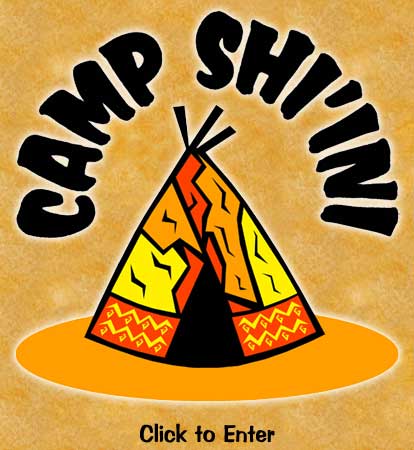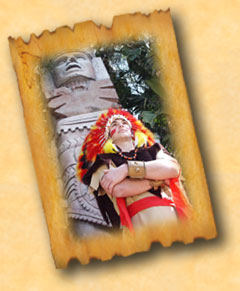 Another Stereotype of the Month entry:
Another Stereotype of the Month entry:
 Another Stereotype of the Month entry:
Another Stereotype of the Month entry:
Speaking out on the theft and abuse of spirituality
Posted: July 20, 2007
by: Shadi Rahimi
SAN FRANCISCO — It was a strange sight, at least in East Los Angeles.
While walking her dogs recently at Arroyo Seco Park, Marisol Crisostomo-Romo, 26, said she spotted a van with a tipi on it. Into it piled a group of white children clutching bows and arrows.
They were members of the five-week-long Camp Shi'ini, "a Native American-themed summer camp" that is named after "a Native American word meaning 'Summer People,"' according to its Web site.
The 60-year-old camp divides children into nine "tribes" and offers activities ranging from horseback riding (in the tradition of the Navajo, Comanche and Eskimo, its Web site stated) and archery (Mohawk, Seminole and Blackfoot) to fishing (Zuni, Iroquois and Apache).
Crisostomo-Romo, who is Pascua Yaqui, immediately wrote the camp a letter and e-mailed 422 people to do the same, beseeching all those "offended and disgusted by cultural exploitation and mainstream society's self-entitlement."
Her anger is echoed across the country by Natives who continue to be frustrated with what they view as misappropriation and abuse of spiritual and cultural practices.
Similar Native-themed camps, nonprofits, centers, programs, workshops, retreats and seminars offered mostly by non-Natives thrive across the country. And the number of non-Native people operating as medicine men and shaman — and often charging for their services — has only grown despite opposition from traditional elders, groups and Native activists.
"We don't charge for ceremonies. People with real sicknesses actually go to these people; we've heard of these people even taking advantage of women," said Charlie Sitting Bull, 54. "That's the danger in people being misinformed. We battle it all the time."
Sitting Bull is a traditional Oglala Lakota from South Dakota who said he is a direct descendant of Chief Sitting Bull. He began noticing the misuse of Native culture as a teenager, when he first saw a Boy Scout troup "dressed as Indians," he said.
Since then, he has confronted Native and non-Native people falsely claiming to be descendants of Chief Sitting Bull and has worked to stop non-Native people from charging for spiritual teachings. Most recently, Sitting Bull said he prevented a white man from charging to teach Sun Dance songs at a Washington state bookstore, which the man had learned from a legitimate medicine man.
Responding to a request from the medicine man himself, Sitting Bull confronted the white man, telling him he could not hold the workshop, and asking for a written apology. The man was arrogant, but eventually obliged, he said.
A non-Native person practicing Native spirituality presents a similar danger to all Natives as a Native person who practices but "isn't clean" — taking drugs or not "living a good life," — Sitting Bull said.
"They actually infect us like a sickness," he said, referring to both scenarios.
In 1993, a decree passed at an international gathering of 500 representatives from 40 different tribes and bands of the Lakota, titled the "Declaration of War Against Exploiters of Lakota Spirituality," stated that immediate action be taken to defend Lakota spirituality from "further contamination, desecration and abuse."
It detailed what it described as the destruction of sacred traditions, reminding Natives of their highest duty — "to preserve the purity of our precious traditions for our future generations, so that our children and our children's children will survive and prosper in the sacred manner intended for each of our respective peoples by our Creator."
Among the "disgraceful expropriation" that even then had "reached epidemic proportions in urban areas throughout the country," according to the leaders, were corporations that charge money for sweat lodges and vision quest programs; Sun dances for non-Natives conducted by charlatans; and cult leaders and new age people who imitate Lakota ceremonial ways and mix in non-Native occult practices.
The decree urged traditional people, tribal leaders and governing councils of all other Indian nations to join "in calling for an immediate end to this rampant exploitation of our respective American Indian sacred traditions."
The decree was published in a newsletter, in controversial author Ward Churchill's 1994 book "Indians Are Us? Culture and Genocide in Native North America," and online.
Since then, an active stand has been taken by medicine men and traditional practitioners even against "Native healers that are out of line," Sitting Bull said.
Responses to the decree from non-Native people on various Web sites explain why they engage in Native spiritual practices.
"I understand the importance of the statement and feel money is being made by the stealing of the traditionalists," Mark Montalban wrote. "I also feel that ghosts and spirits can enter your life and give purpose and direction."
But many Native people disagree, arguing that the appropriation of spirituality is not only disrespectful, but also dangerous if practiced incorrectly and by non-Natives.
"One can study Native culture all they want, but if it's not Native blood flowing through their veins then they'll never truly understand those ways and how to use them," said Anthony Thosh Collins, 25, of the Pima, Osage and Seneca-Cayuga tribes. "I support the use of our Native culture to help heal this world, but only through the guidance of one of our own qualified elders."
The movement against non-Natives appropriating and sometimes selling Native spirituality is growing, with younger Natives joining the forefront.
In her letter to Camp Shi'ini, Crisostomo-Romo explained the sacred nature of the face paint and war bonnets displayed on its Web site, saying, "Non-Natives don't have business messing with these things."
She suggested the camp instead teach children about modern issues faced by Native people, including the desecration of sacred sites, poverty and substance abuse.
It is important for non-Natives to understand that Natives do not exist only in museums or in Western movies: "We are a people who have a future and who want the best for our children," Crisostomo-Romo said.
"The very notion of trying to recreate a lifestyle of a people that are still in vibrant existence is purely ridiculous," she said. "Native people are not just about bows and arrows, feathers and dream catchers. The depth and beauty of our cultures can never be captured in a summer camp."

The website in question:
For sixty years, Camp Shi'ini has provided active and entertaining camp activities for boys and girls without a prolonged absence from home. Our goal is to provide an enjoyable and safe environment for children, while also educating them about Native American folklore through interactive and action-packed surroundings. We are the "ultimate camping experience" in the greater Pasadena area. Since 1947, Camp Shi'ini has developed an outstanding legacy, creating childhood memories bound to last a lifetime. It is truly an experience that captivates the hearts and imaginations of every camper. We are extremely proud to invite you to join us for our best season yet, and if there was ever a summer not to miss ... this is the one.
Camp Theme
Camp Shi'ini is a Native American themed camp that lasts five weeks each summer. Shi'ini, pronounced "Shee-nee," is a Native American word meaning "Summer People." Our theme is portrayed in several daily events, including: horseback riding, fishing, canoeing, archery, athletics, hiking, games, crafts, swimming, and an extraordinary month-long treasure hunt! While at camp, the children are broken into various "tribes" according to their ages. Each of these tribes functions as a separate unit throughout the day. There are nine tribes, each composed of 13 campers and 2 counselors.
Rob's comment
Camp Shi'ini divides its children into nine "tribes," but they all participate in similar activities: horseback riding, archery, fishing, canoeing, etc. But did the Eskimo ride horses or shoot arrows? Did the Navajo or the Apache paddle canoes? Did the Comanche or the Blackfeet fish?
The camp promotes the idea that all Indians were the same. In particular, that they all fit the stereotypical Plains Indian model, with its feathered bonnets, war paint, horseback riding, and archery. Seven of the nine "tribes" aren't Plains Indians, but undoubtedly kids won't learn much about their diverse cultures. They probably won't learn anything about Indian cultures that don't fit the Plains model.
This is basically the same problem that the Y-Indian Guides program fosters: homogenizing hundreds of Indian cultures into a limited set of stereotypes. It's wrong for the same reasons. Read up on the Y-Indian Guides and apply the same analysis here.
P.S. Charlie Sitting Bull isn't necessarily a good representative of healthy Native spirituality. See this blog about him (accessible by invitation only) for details.
Related links
Tipis, feather bonnets, and other Native American stereotypes
|
. . . |

|
All material © copyright its original owners, except where noted.
Original text and pictures © copyright 2007 by Robert Schmidt.
Copyrighted material is posted under the Fair Use provision of the Copyright Act,
which allows copying for nonprofit educational uses including criticism and commentary.
Comments sent to the publisher become the property of Blue Corn Comics
and may be used in other postings without permission.